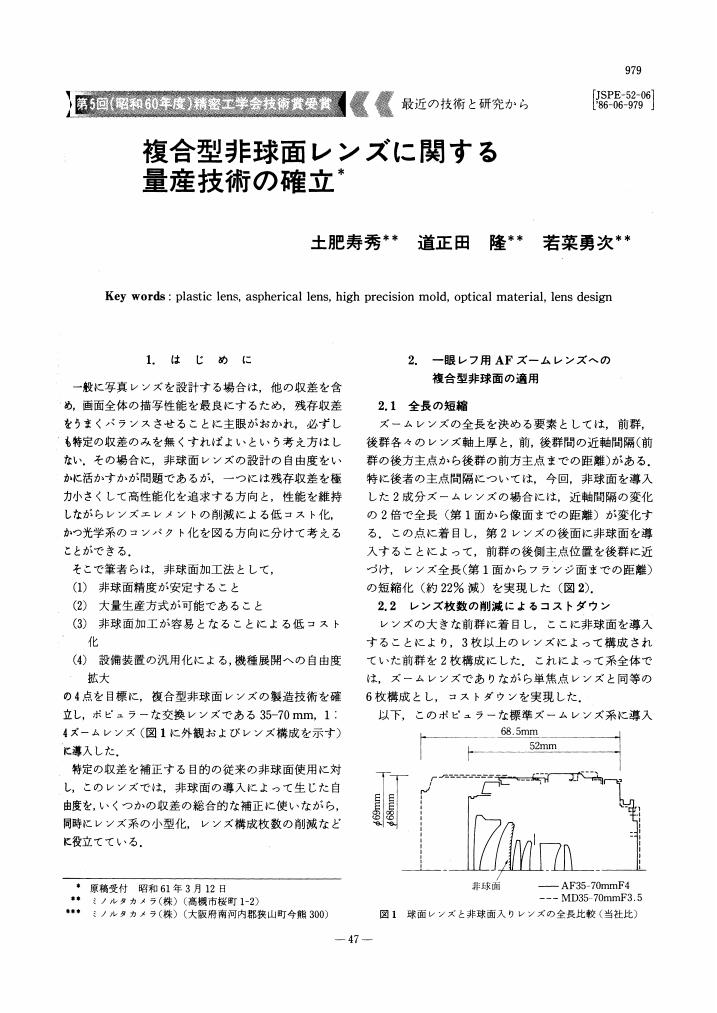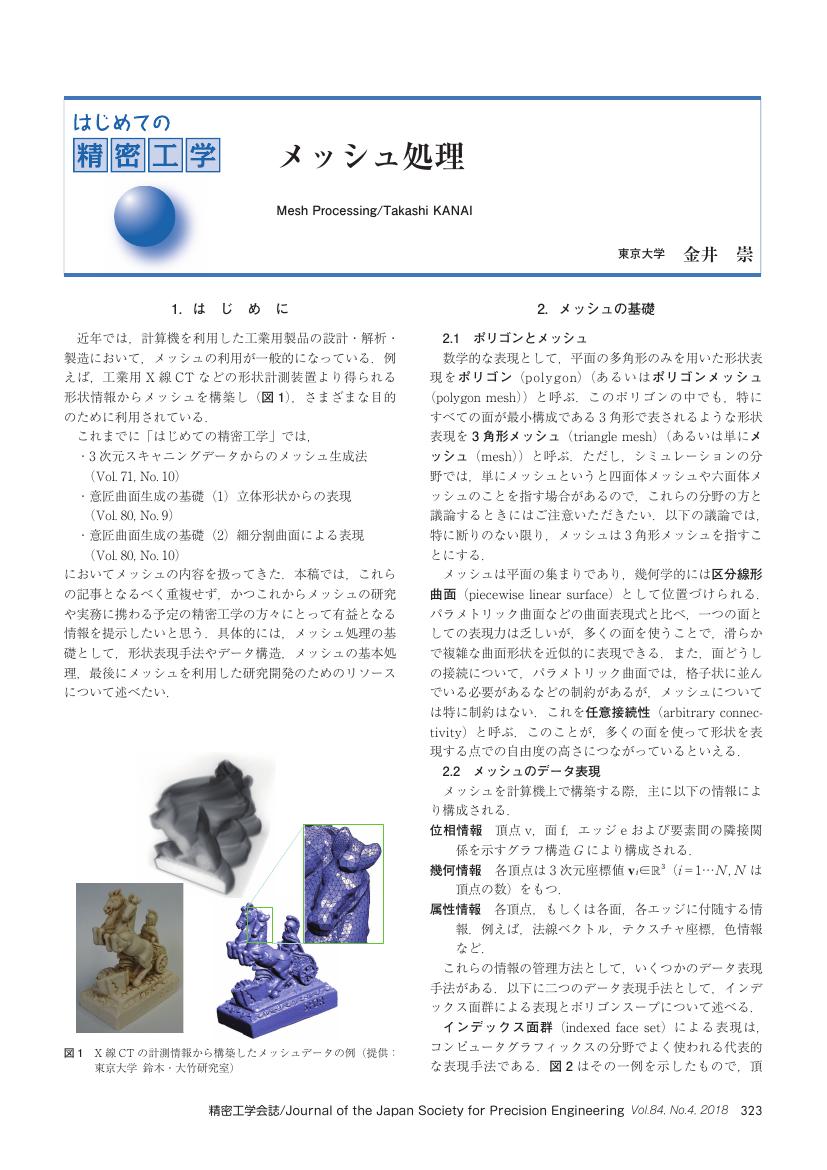2 0 0 0 OA ウォータージェット加工
- 著者
- 吉浦 弘樹
- 出版者
- 公益社団法人 精密工学会
- 雑誌
- 精密工学会誌 (ISSN:09120289)
- 巻号頁・発行日
- vol.86, no.7, pp.537-540, 2020-07-05 (Released:2020-07-05)
- 参考文献数
- 2
2 0 0 0 OA 「お客様が稼げる機械」を作る自動旋盤の新しい形
- 著者
- 山野 真 敷村 達也 鈴木 直彦 和田 弘光 佐藤 樹 道本 隆裕
- 出版者
- 公益社団法人 精密工学会
- 雑誌
- 精密工学会誌 (ISSN:09120289)
- 巻号頁・発行日
- vol.89, no.10, pp.727-730, 2023-10-05 (Released:2023-10-05)
2 0 0 0 OA ナノインプリントトータルソリューション
- 著者
- 大井 秀雄
- 出版者
- 公益社団法人 精密工学会
- 雑誌
- 精密工学会誌 (ISSN:09120289)
- 巻号頁・発行日
- vol.86, no.4, pp.263-266, 2020-04-05 (Released:2020-04-05)
- 参考文献数
- 1
2 0 0 0 OA ドリルの形と穴加工
- 著者
- 明石 剛二
- 出版者
- 公益社団法人 精密工学会
- 雑誌
- 精密工学会誌 (ISSN:09120289)
- 巻号頁・発行日
- vol.85, no.10, pp.839-842, 2019-10-05 (Released:2019-10-05)
2 0 0 0 OA ボルト締結部の剛性向上に関する研究 接合面圧力の均一化
- 著者
- 大岩 孝彰 太田 匠 大久保 聡
- 出版者
- 公益社団法人 精密工学会
- 雑誌
- 精密工学会誌 (ISSN:09120289)
- 巻号頁・発行日
- vol.65, no.4, pp.537-541, 1999-04-05 (Released:2009-04-10)
- 参考文献数
- 7
- 被引用文献数
- 2 2
The purpose of this study is to improve the stiffness of the bolted joint by means of uniforming the contact pressure distribution. Two plane surfaces of the conventional bolted joint have produced ununiformity of the contact pressure distribution and have caused decrease of the stiffness. In this paper, shape modification of bolted surfaces was performed in simulation by the finite element method and in experiments so that the pressure distribution is uniform. Moreover, grinding simulation by the finite element method estimated optimum grinding conditions for adopting a unique method to modify the surface. The measurements of the contact pressure between the modified plate and the plane base were performed and showed considerable decrease of the maximum pressure.
2 0 0 0 OA テラヘルツ波が拓く超高速無線通信 —光ファイバ通信並みの高速無線の実現を目指して—
- 著者
- 永妻 忠夫
- 出版者
- 公益社団法人 精密工学会
- 雑誌
- 精密工学会誌 (ISSN:09120289)
- 巻号頁・発行日
- vol.82, no.3, pp.221-224, 2016-03-05 (Released:2016-03-05)
- 参考文献数
- 33
2 0 0 0 OA 人工内耳の現状と展望
- 著者
- 太田 岳 任 書晃 日比野 浩
- 出版者
- 公益社団法人 精密工学会
- 雑誌
- 精密工学会誌 (ISSN:09120289)
- 巻号頁・発行日
- vol.83, no.11, pp.992-995, 2017-11-05 (Released:2017-11-05)
- 参考文献数
- 7
- 被引用文献数
- 1
2 0 0 0 OA 超伝導量子ビット技術
- 著者
- 阿部 英介 玉手 修平
- 出版者
- 公益社団法人 精密工学会
- 雑誌
- 精密工学会誌 (ISSN:09120289)
- 巻号頁・発行日
- vol.85, no.12, pp.1048-1051, 2019-12-05 (Released:2019-12-05)
2 0 0 0 OA 周辺視と固視微動に学ぶ「傷の気付き」アルゴリズム
- 著者
- 青木 公也 舟橋 琢磨 輿水 大和 三和田 靖彦
- 出版者
- 公益社団法人 精密工学会
- 雑誌
- 精密工学会誌 (ISSN:09120289)
- 巻号頁・発行日
- vol.79, no.11, pp.1045-1049, 2013-11-05 (Released:2014-01-05)
- 参考文献数
- 13
- 被引用文献数
- 6 5
There are many such practical cases that it is difficult to detect defects even by a visual inspection. These defects, such as very small cracks of pattern and thin stains, etc., are slightly different with each other and hidden in the background texture. Even when the skilled inspector can detect these defects, they are undetectable by the traditional image processing algorithms. This paper describes the detailed program for detecting irregular region involving such invisible defects inspired by human vision architectures. This program has been named “KIZUKI” algorithm in this study. Two kinds of typical vision theories are used to model the “KIZUKI” process : the peripheral vision and the involuntary eye micro-vibration theories found in the field of psychology of vision. It consists of three steps : first step for forming low resolution images by a variable re-sampling, and the second step for detecting relatively salient regions at each low resolution image, and the last step for integrating these regions. Experimental results indicate that our approach is very reasonable in intuitive interpretation of human vision. Since our programs are very simple in architecture and effective in performance, it might be applicable equally to the quite different kinds of defects.
2 0 0 0 OA 金属のドリル加工におけるバリ無し化
- 著者
- 和田 浩明 吉田 薫
- 出版者
- 公益社団法人 精密工学会
- 雑誌
- 精密工学会誌 (ISSN:09120289)
- 巻号頁・発行日
- vol.66, no.7, pp.1109-1114, 2000-07-05 (Released:2009-04-10)
- 参考文献数
- 13
- 被引用文献数
- 5 5
Many kinds of burrs are formed in various fabricating processes. These burrs are often manually removed even in modern factories. Therefore, these burrs make troubles on production lines in terms of automation, quality of products and working environment. In this paper, the burr formation mechanism on the exit side in drilling of metals is discussed. The idea is that the burr formation mechanism is equivalent to that of the deflection of cantilever changing the thickness under equiload. On the basis of the idea, authors have designed the burrless drill, in which the corner of cutting edge is cut by a little larger compared with a normal drill. The effect of the burrless drill is discussed in the present paper.
2 0 0 0 OA 強力超音波用振動子
- 著者
- 足立 和成
- 出版者
- 公益社団法人 精密工学会
- 雑誌
- 精密工学会誌 (ISSN:09120289)
- 巻号頁・発行日
- vol.75, no.4, pp.479-483, 2009-04-05 (Released:2011-02-07)
- 参考文献数
- 6
- 被引用文献数
- 4
2 0 0 0 OA 複合型非球面レンズに関する量産技術の確立
- 著者
- 土肥 寿秀 道正田 隆 若菜 勇次
- 出版者
- 公益社団法人 精密工学会
- 雑誌
- 精密工学会誌 (ISSN:09120289)
- 巻号頁・発行日
- vol.52, no.6, pp.979-982, 1986-06-05 (Released:2009-06-30)
2 0 0 0 OA 小型レーダ衛星ASNARO-2による高精度地球観測技術
- 著者
- 小川 俊明
- 出版者
- 公益社団法人 精密工学会
- 雑誌
- 精密工学会誌 (ISSN:09120289)
- 巻号頁・発行日
- vol.86, no.12, pp.942-945, 2020-12-05 (Released:2020-12-05)
2 0 0 0 OA メッシュ処理
- 著者
- 金井 崇
- 出版者
- 公益社団法人 精密工学会
- 雑誌
- 精密工学会誌 (ISSN:09120289)
- 巻号頁・発行日
- vol.84, no.4, pp.323-327, 2018-04-05 (Released:2018-04-05)
- 参考文献数
- 13
- 被引用文献数
- 1
2 0 0 0 OA ダイヤモンド
- 著者
- 戸倉 和
- 出版者
- 公益社団法人 精密工学会
- 雑誌
- 精密工学会誌 (ISSN:09120289)
- 巻号頁・発行日
- vol.78, no.3, pp.212-215, 2012-03-05 (Released:2012-09-05)
- 参考文献数
- 5
2 0 0 0 OA 時計における最近の歯車動向
- 著者
- 前原 芳文
- 出版者
- 公益社団法人 精密工学会
- 雑誌
- 精密工学会誌 (ISSN:09120289)
- 巻号頁・発行日
- vol.69, no.3, pp.357-360, 2003-03-05 (Released:2009-04-10)
- 被引用文献数
- 1 1
2 0 0 0 OA バイオミメティクスによる粘着技術の革新
- 著者
- 前野 洋平 山本 礼
- 出版者
- 公益社団法人 精密工学会
- 雑誌
- 精密工学会誌 (ISSN:09120289)
- 巻号頁・発行日
- vol.81, no.5, pp.385-388, 2015-05-05 (Released:2015-05-05)
2 0 0 0 OA 人の手で金型づくりの基本を身に付ける“人づくり”
- 著者
- 伊熊 英明 牟田 真也
- 出版者
- 公益社団法人 精密工学会
- 雑誌
- 精密工学会誌 (ISSN:09120289)
- 巻号頁・発行日
- vol.85, no.6, pp.494-497, 2019-06-05 (Released:2019-06-05)
2 0 0 0 OA シリコン量子ビット素子の研究動向
- 著者
- 森 貴洋 樽茶 清悟
- 出版者
- 公益社団法人 精密工学会
- 雑誌
- 精密工学会誌 (ISSN:09120289)
- 巻号頁・発行日
- vol.85, no.12, pp.1052-1056, 2019-12-05 (Released:2019-12-05)
- 参考文献数
- 11
2 0 0 0 動植物へのプロジェクションマッピング
- 著者
- 森本 有紀
- 出版者
- 公益社団法人 精密工学会
- 雑誌
- 精密工学会誌 (ISSN:09120289)
- 巻号頁・発行日
- vol.88, no.11, pp.828-831, 2022-11-05 (Released:2022-11-05)
- 参考文献数
- 12














